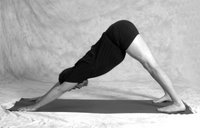Dog Pose is for Dogs?

Downward facing dog pose is one of my bread and butter poses. It does it all. It is a backbend, a forward bend, a standing pose, and an inversion. It prepares me for backbends, arm balances, and inversions. It is a great counter poses for backbends and lotus poses.
We are told that the great sages developed the conscious skillful movements of asana from observations of nature. The movements of animals supposedly inspired the yogis. They, as well, compared the movement of young and old humans.
We assume that how movement is good for animals is good for humans. But I question how dog pose is for dogs is not the same for humans.
I researched dog anatomy and kinesiology. I found out that a dog only has about 70 degrees of shoulder flexion or sometimes called elevation. They can bring their front legs [arms] into their side but elevates that front leg less than ninety degrees away from their body before their scapula [shoulder blade] begins to move.
http://cal.vet.upenn.edu/saortho/appendix_b/appb.htm
http://siriusdog.com/articles/anatomy-working-canine-dog-shoulder.htm
The human is said to have 180 degrees of shoulder elevation. But the last 20 degrees depends mostly on thoracic spine extension. The human shoulder is a quite complex system of relations amongst the spine, ribs, breastbone, shoulder blade, collarbone, and arm. Our shoulders are designed for a biped that needs shoulder mobility for upper extremity functions. A dog shoulder is designed for a quadruped that needs mostly stability for locomotion.
Everyone has seen a dog wake up from a nap and "stretch" in his or her "dog" pose. Their whole spine backbends in an effortless way. Since they have such little shoulder elevation, they begin to backbend very shortly after they begin their movement. Dog photo from http://www.stretch.com/carol.htm
Yoga teachers have difficulty presenting Down Dog with out new students impinging their rotator cuff or tensing their top shoulder muscles and rounding their upper back into rigidity. I have demanded that my new students keep their head up slightly in downward facing dog. This facilitates upper back extension to prepare the shoulder blades and collarbones to be in optimal position and action is the foundation of the rotator cuff muscles to do their job. They are to cinch or glide the head of the humerus [arm bone] down as the humerus elevates upwards, clearing the A-C [acrominoclavicular] shelf. This prevents impingement.
It seems that a dog does dog pose to stretch the spine into backbend. A human does dog pose to activate the spine, shoulder blades, and collarbones into backbend to prepare the arm to elevate without impingement.
If a human want to stretch their spine like dogs do in dog pose, they would have to do urdhva danurasana [wheel pose].

4 Comments:
I'm really enjoying the info on your blog!
Dogs usually do 'down dog' to ask another dog to play - something that we might want to keep in mind in our own practices!
Woof! I like to howl at the full moon, should I also try that in urdhva?
Great resource. keep it up!!Thanks a lot for interesting discussion, I found a lot of useful information!With the best regards!
David
Nice post, this will really help a lot of people in practicing this particular yoga pose.
Post a Comment
<< Home